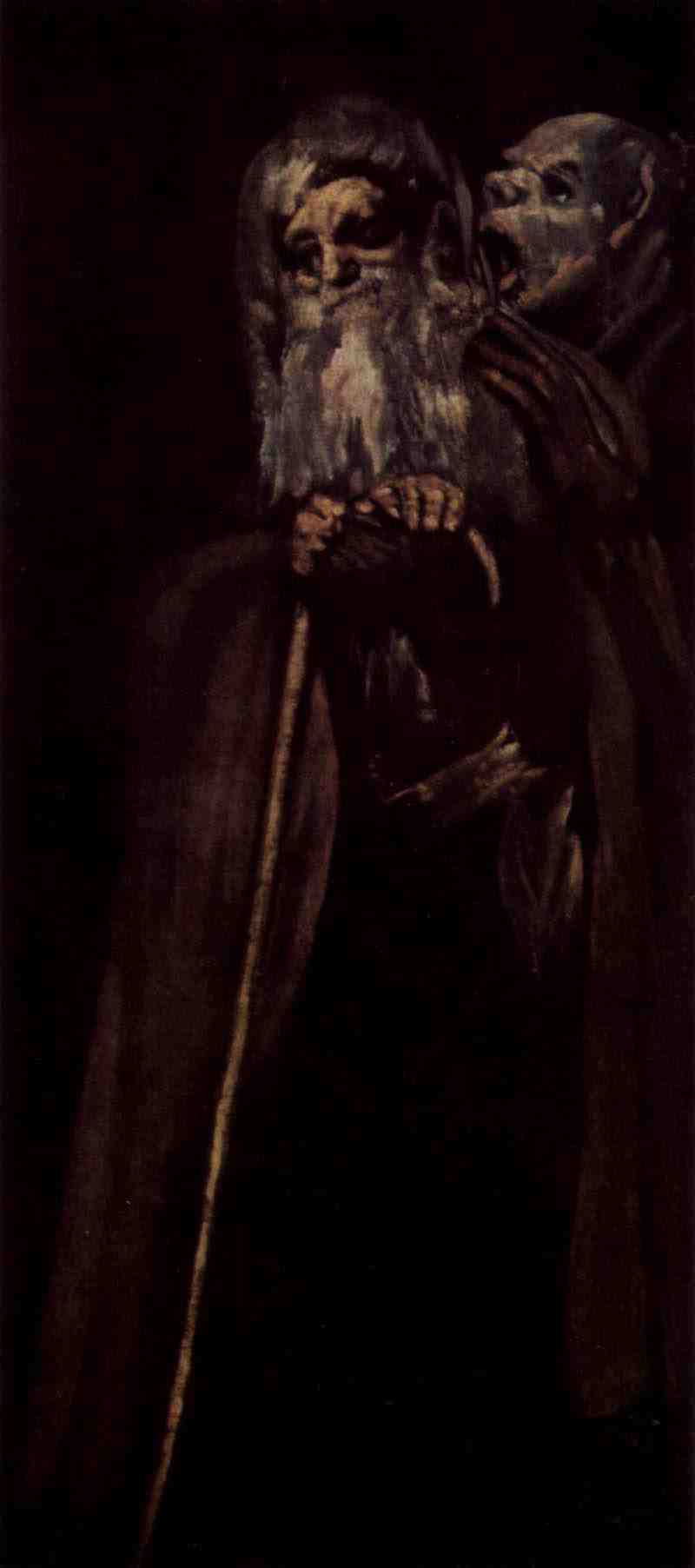
Series of "pinturas negras" scene: Two Old Men. Francisco de Goya y Lucientes
1821-1823, oil on canvas, 144 × 66 cm
Madrid, Museo del Prado
----
Serie der »pinturas negras«, Szene: Zwei Alte. Francisco de Goya y Lucientes
1821–1823, Öl auf Leinwand, 144 × 66 cm
Madrid, Museo del Prado
---
----
Fine Art Prints | Greeting Cards | Phone Cases | Lifestyle | Face Masks | Men's , Women' Apparel | Home Decor | jigsaw puzzles | Notebooks | Tapestries | ...
----
Two Old Men, also known as Two Monks or An Old Man and a Monk (Spanish: Dos viejos, Dos frailes, or Un viejo y un fraile) are names given to one of the 14 "Black Paintings" painted by Francisco Goya between 1819-23. Goya was then in his mid-70s and in mental and physical distress. He painted the works on the interior walls of the house known as "The House of the Deaf Man" (Quinta del Sordo) that he purchased in 1819.
Quinta del Sordo, c. 1900
In the picture, two elderly figures dressed in friar's habits stand before a black background. The man in front has a long grey beard, is tall and rests on a cane. He may represent Chronos, the god of time. Beside him is a highly-caricatured figure whose face is animal-like. This figure seems to be shouting into the ear of his companion, which might be an allusion to Goya's deafness.
There is a noticeable difference between the treatment of the two figures. Calmly resting on his walking stick with a sad but serene expression, the bearded man recalls the philosophers depicted by Velázquez, which had been copied by Goya. In vivid contrast, the features of his monstrous companion recall the friars depicted by Goya in his Caprichos and Disparates.
The black paintings were not intended to be seen by anyone but the artist. Two Old Men likely occupied a position on the first floor, opposite Judith and Holofernes.[1] Like other paintings in the series, it was transferred to canvas between 1873-74 under the supervision of Salvador Martínez Cubells, a curator at the Museo del Prado. The owner, Baron Emile d'Erlanger, donated the canvases to the Spanish state in 1881, and they are now on display at the Museo del Prado.[2]
Footnotes
Fernández, G. "Goya: The Black Paintings". theartwolf.com, August 2006. Retrieved 4 April 2010.
Hughes, 16–17
Bibliography
Benito Oterino, Agustín, La luz en la quinta del sordo: estudio de las formas y cotidianidad, Madrid, Universidad Complutense, 2002, p. 33. Edición digital ISBN 84-669-1890-6.
Bozal, Valeriano, Francisco Goya, vida y obra, (2 vols.) Madrid, Tf. Editores, 2005. ISBN 84-96209-39-3.
Bozal, Valeriano, Pinturas Negras de Goya, Tf. Editores, Madrid, 1997.
Glendinning, Nigel, Francisco de Goya, Madrid, Cuadernos de Historia 16 (col. «El arte y sus creadores», nº 30), 1993.
Hagen, Rose-Marie and Hagen, Rainer, Francisco de Goya, Cologne, Taschen, 2003. ISBN 3-8228-2296-5.
Hughes, Robert. Goya. New York: Alfred A. Knopf, 2004. ISBN 0-394-58028-1
Retrieved from "http://en.wikipedia.org/"
All text is available under the terms of the GNU Free Documentation License


